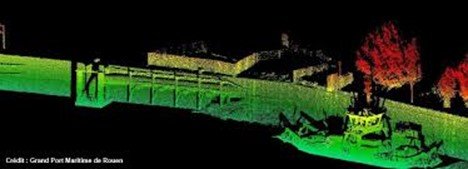| Comparison | 2D LIDAR | 3D LIDAR |
|---|---|---|
| Number of light beams emitted | One beam of light | Several beams of light |
| Axis of focus during light beam emission | X and Y axes (horizontal plane) | X, Y, and Z axes (vertical plane) |
| Cost | Less expensive | More expensive |
| Industrial applications | Ranging and detection | Mapping and scanning landscapes |
| Ease of portability | Smaller size, easily portable | Larger size, less portable |
| Accuracy of a landscape’s or water depth | Less accurate | Highly accurate |
LIDAR technology uses sensors that illuminate light to collect distance information between target objects and the light course or between objects and their velocity. The time it takes for the illuminated light to be reflected its source after it bounces off the target object can give accurate information on object velocity and distance. The accuracy is enabled by the constant speed of light in air.
Categorization of LIDAR technology systems is based on the number of light beams that can be focused on a surface and the surface scanning mode. Either way, LIDAR systems can 1D, 2D, or 3D. This article will compare 2D and 3D LIDAR systems.
2D LIDAR
2D LIDAR is designed to emit a single beam of light towards the target object on a horizontal plane to collect objective data on the X and Y axes. Usually, the LIDAR sensor spins to collect sufficient information on both X and Y coordinates. Among other features, a 2D LIDAR sensor’s size enables ease of portability when compared to their 3D counterparts. 2D LIDAR sensors are best suited for carrying outranging and detection activities.
3D LIDAR
How does 3D LIDAR technology work? As opposed to its 2D counterpart, it uses particular types of sensors that spin at 360 degrees emitting several beams of light towards an object’s vertical plane to gather the target’s X, Y, and Z coordinates. 3D technology is suitable for landscape mapping and scanning.
Comparisons between 2D and 3D LIDAR
- Number of light beams emitted
While a 2D LIDAR system is designed to spin as it emits only one beam of light towards a surface, a 3D LIDAR one is designed to emit several beams of light to collect more detailed object data.
- The axis of focus during light beam emission
Because 2D LIDAR intends to collect object data only on its X and Y axes, the beam of light is only shot along the object’s horizontal plane. Conversely, 3D LIDAR focuses its beam along its target’s vertical plane to capture 3-dimensional data on the X, Y, and Z axes. This mode of scanning provides more detailed object information.
- Cost
While both LIDAR technologies have various industrial applications, 3D LIDAR is more expensive than its 2D counterpart. That is partly because of its accuracy level and the detailed object information its ability to capture.
- Industrial applications
2D LIDAR is well suited when conducting activities that require a lot of ranging and detection due to the detailed horizontal data it can capture. On the flip side, 3D LIDAR systems are best suited for mapping and scanning landscapes because of the volume of data this model can capture on an object’s Y-axis.
- Ease of portability
2D LIDAR sensors are smaller in size than the 3D LIDAR system; thus, their location can be easily and comfortably changed.
- Accuracy of a landscape’s or water depth
3D LIDAR system is costlier than 2D for a reason. Their ability to accurately determine a water body’s depth or landscape elevation angle or height is astounding. Unlike 2D sensors, 3D sensors cast light along an object’s vertical plane, capturing sufficient details on the Y-axis, thus achieving higher depth accuracy levels.
The bottom line
LIDAR technology utilizes a beam of light cast from its sensors to extract object information for accurate and reliable decision making. This technology can be categorized as either 2D or 3D basing on the number of light beams that are emitted towards the target object and the mode of surface scanning. 2D LIDAR emits a single beam of light, whereas 3D emits several beams, and as a result, their applications vary in different industries.



